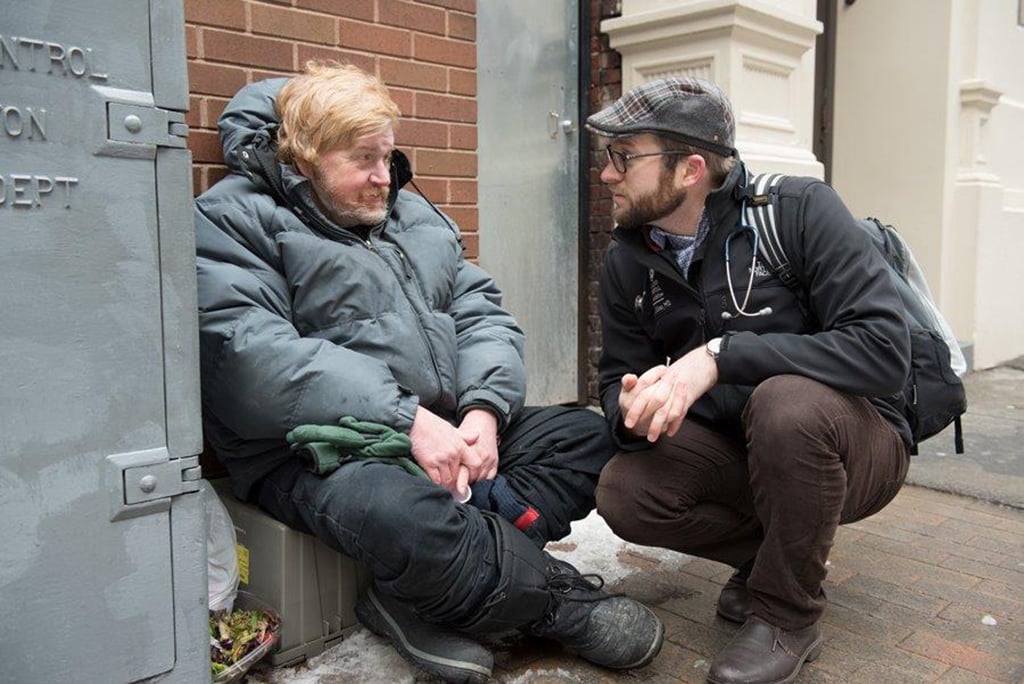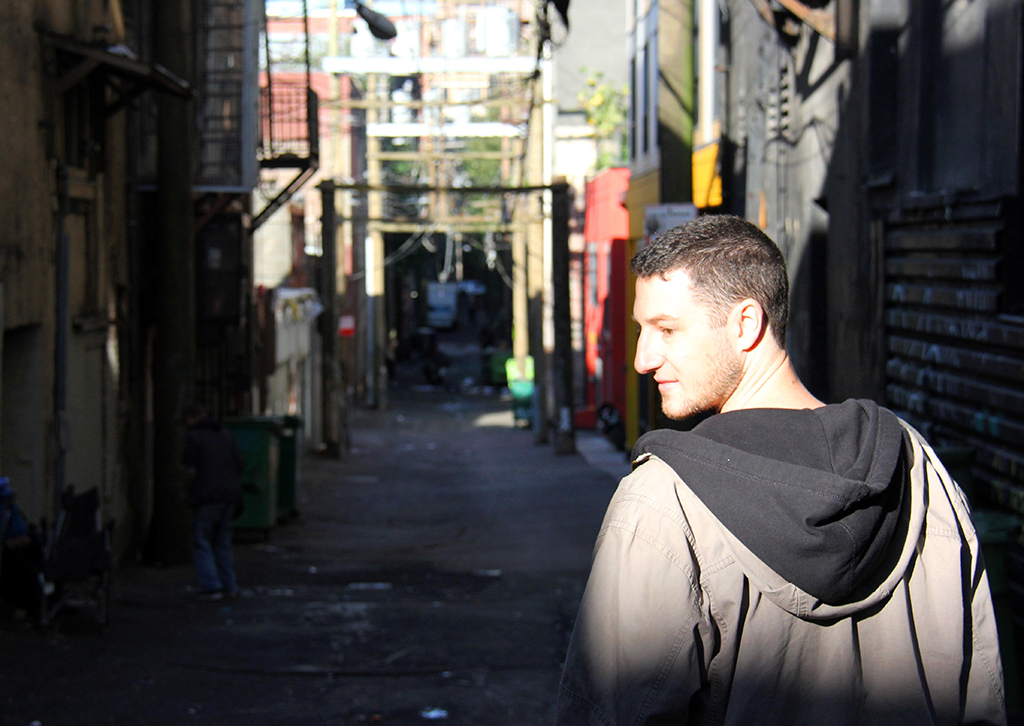As a staff reporter with the Georgia Straight, Travis Lupick closely covered Vancouver’s opioid overdose crisis as deaths began to rise in 2015 and 2016. He documented the start of an unsanctioned overdose prevention site in the Downtown Eastside that led to the low-barrier harm reduction model being adopted across B.C. and in other parts of Canada, and spent years following the policy discussions and the human tragedy of the toxic drug crisis.
In 2017 he published his first book, Fighting for Space: How a Group of Drug Users Transformed One City’s Struggle With Addiction. The book traced the roots of Vancouver’s drug user activism and the raucous political fights to run needle exchange programs and unofficial safe injection sites, leading to the opening of Insite, North America’s first legal supervised consumption site, in 2003.
Lupick has now turned his attention to the United States, where 100,000 people died of overdose in 2021 but basic harm reduction methods such as needle exchanges still face pushback in some states. His new book, Light Up the Night: America’s Overdose Crisis and the Drug Users Fighting for Survival, looks at the overdose crisis in the U.S. through the life experiences of two drug user activists, Jess Tilley and Louise Vincent.
Lupick recently spoke to The Tyee from his home in Ventura, California. This interview has been edited for length and clarity.
The Tyee: When you were writing Fighting for Space, did you have it in your mind at that point that you wanted to take a look at what was happening in the United States, or did that come later?
Travis Lupick: I knew that I wanted to write a second book and I knew that I wanted it rooted more in the ongoing overdose crisis, as opposed to where Fighting for Space looks back at history.
Then I took Fighting for Space on a mini book tour, mostly of the northeastern United States. On that tour, I was kind of just keeping my eyes open for interesting stories and something that I might be able to fit into the larger themes of drug user activism in the current opioid crisis. And then I met with this one woman who I thought was just incredible. Then a couple of weeks later I met this second woman who I thought was just incredible, and then I found out that the two of them knew each other and were working together. As I started to get to know them a little bit better, a story emerged and I thought they were amazing enough to write a whole book about.
In some ways, I feel like it's this ongoing story of drug user activism in the United States that continues the story I told in Fighting for Space, even though they’re set in different places. I think that there's a chronological continuity there because Fighting for Space looks at drug user activism from the early 1990s to around 2010.
Vancouver's a little bit ahead of the United States on drug user activism. We had the continent’s first injection site in 2003, and before that the Vancouver Area Network of Drug Users was founded in 1997, so Vancouver's had this history of drug user activism for a while.
While some areas of the United States have that as well, this more national movement that I write about in Light Up the Night — it’s kind of just taking off right now.
I think we always have this idea that the U.S. is behind Canada in terms of harm-reduction policies, but I'm not sure that's true. What's your take on the biggest differences between Canada and the U.S. when it comes to drug policy and harm reduction?
I do have to be careful not to overgeneralize, because you had drug user activism associated with needle exchanges in the Seattle area in the mid-1990s. You had a vocal activist collective based in New York, in the Bronx, and of course there was HIV-AIDS and LGBTQ+ activism in response to the AIDS crisis. It got needle exchanges going very early in the United States, and of course intravenous injection users were also affected by the AIDS crisis — that was the spark for early drug user activism and harm reduction in the United States.
But it's fair to say that Vancouver took it further and faster than any other region. From 2003 right up until 2016, we were the only city in the entire continent to have a supervised injection site. And since 2016, subsequent sites have only opened in Canada. They’re still fighting for a sanctioned site in the United States, in cities like Philadelphia and New York, and Seattle.*
So for sure, there were pockets, but it didn't move anywhere near as far and as fast as Vancouver — until now.
Do you have any thoughts about why this is the moment?
Sadly, I think this is a moment borne out of crisis. The overdose crisis in the United States has killed 100,000 people in the last 12 months. That compares to an annual average of around 15,000 in the 1990s. So 25 years later, we've jumped from 15,000 to 100,000 deaths a year.
That's where I think this new sort of energy in the American harm reduction movement is coming from. The activism and the harm reduction in Fighting for Space was very much launched during Vancouver's overdose crisis of the 1990s, when we saw annual deaths jump from 100 to 400 in a few years. Just as we saw in Vancouver in the 1990s, we're seeing harm reduction and drug user activism jump-started in the United States right now by this crisis.
I wanted to talk about Jess Tilley and Louise Vincent a little bit because they are such compelling characters in your book. Could you tell me a bit about the process of spending time with them and how their stories ended up shaping the book?
I met Jess in Boston. I was speaking at Boston Health Care for the Homeless, which is a big sort of hospital drop-in and clinic. The organizers had assigned somebody to do an intro and opening for me and that ended up being Jess Tilley. And we didn't know each other before that, but we got to know each other that day as we were building a mock safe injection site inside the hospital as a demo for what could be.

Jess lives about two hours outside of Boston in a beautiful little town called Northampton. And I made a number of trips there over a couple of years, staying for about a week each time on Jesse's couch and interviewing her on her back porch, late into the night.
Louise Vincent I met because I heard that she was sort of the person to know for drug user activism in Greensboro, North Carolina. Someone had organized a talk for me there at a church about Fighting for Space, and I was told last minute that Louise couldn’t make it because she was in the hospital.
A friend of a friend said, “If you're in Greensboro can you bring her some flowers for me?” And so I bought some flowers and I went to the hospital. It was just like this incredible scene out of a war movie, where I walk into her hospital room and she's sitting on the bed in a gown and she's got IVs in her. She's got activists from across the region on one side of the room holding a meeting. She's on the phone with folks in New Orleans organizing a protest, and then while she's on the phone, she's got her computer in front of her and she's got a Zoom meeting going on while she's writing emails. And she’s doing all of this simultaneously while she's about to go into the operating room to have her leg amputated.
I'm not even sure she actually remembers that first meeting with me because there was so much going on in the room. I just kind of quickly popped in and said “hello,” but she briefly mentioned that I should come back and visit her and spend more time with her.
I don't know if she was just being polite or whatever, but I called her up and I invited myself out there and flew to Greensboro and then flew there again four or five more times, again doing interviews late into the night. And what Louise is doing there is amazing: she's running a needle exchange, a drop-in, and she's doing some drug user organizing out of that needle exchange.
They had all these experiences that really illustrated all of the barriers that people who use drugs face. Did you talk to them about whether it would be OK to use that material that's so personal?
So many people who end up with problematic drug use, especially with heroin, are not doing it for fun. They're doing it because they're dealing with past trauma. For women, it’s often sexual abuse that eventually leads to a heroin addiction. These are people who are healing and self-medicating, and have been rejected by the system, and that was very much the story for Jess and Louise.
Louise struggles with bipolar disorder and felt like she never just quite fit in with society and was treated quite badly by society throughout her youth. And then subsequently she suffered all sorts of abuse through a series of bad boyfriends and things like that, so there's a lot of trauma in Louise’s past.
Jess, similarly, was sexually abused as a child and sexually abused again through her teen years. The first time she did heroin she felt all right for the first time in a very, very long time.
So that's how these two women came to problematic drug use and then later found activism out of that drug use, and I really go to great lengths establishing that narrative in the book. I think it's so important that we understand that people who use drugs are often self-medicating; they are often victims of trauma and mental illness. Because I think if we understand that, then we understand that if you're throwing these people in jail, all you're doing is victimizing the victims.
We had a lot of talks about how such personal experiences would fit into the book, but immediately they both understood not only that that was what I wanted to do, but that was what they wanted to do. Right from the get-go, the idea was we want to explain harm reduction and we want to explain drug user activism. We want to explain it through [their] stories.
There's a purpose to this book, it’s not just a narrative. We want to explain harm reduction to people, and we want to explain trauma and addiction to people. They’ve both been activists for a very long time and understand the value of stories, and understand how important it is to get harm reduction to a wider audience.
I think of the United States as being the originator of the war on drugs, an approach that emphasizes enforcing laws that prohibit drug use, trafficking and manufacturing. Do you think there’s been a shift away from that war-on-drugs mindset, which focuses so heavily on law enforcement and incarcerating drug users? And do you think it's filtered up to decision-makers?
I think it's very fair to say that the United States is where the war on drugs began, where it’s perpetuated and where it has spread to the rest of the globe. It was the United States that lobbied the United Nations to push hard drug laws on countries around the world. It was the [ambassador of the] United States who actually visited Vancouver ahead of Insite’s opening and said, “Do not do this.”
You actually do see bipartisan support across both the Democrat and Republican parties on issues like unfair sentencing for so-called “white drugs” and “black drugs,” and for general sentencing reform and prison reform. Sadly, these are the exceptions to the rule. The United States’ war on drugs very much continues, and since fentanyl arrived, has intensified in a lot of ways.
Just as that prison reform movement was picking up, fentanyl arrived and lawmakers were desperate to show their constituents they were doing anything to stop fentanyl. And what most of them right across the country decided on were stiffer penalties for drug use involving fentanyl and dealing fentanyl.
From there, you saw the development of something called a drug-induced homicide charge, which is something we've not seen in Canada. These laws have been passed across the country, saying if you're caught dealing fentanyl, you're going to go to jail for a very long time. We're not going to charge you with dealing, we're going to charge you with murder.
How that law has been used is not only against dealers, but against a married couple who uses drugs together and one of them dies, and the other one goes to prison for murder. In the book, I mention the story of two brothers: one of them dies, one of them picked up the drugs — and he goes to jail for murder.
And while there is some reform around things like Suboxone distribution and needle exchanges, in other ways — especially on stiffer sentences for fentanyl — the war on drugs in the United States is really being waged heavier than ever before.
Jess Tilley and Louise Vincent both live in smaller cities, and when we see supervised injection sites proposed, it’s always in big cities. When activists in Canada started setting up overdose prevention sites, they were a lower-barrier version of the supervised injection site, and they were able to be set up in smaller towns like Nanaimo, B.C. and Lethbridge, Alberta. Has that been happening in the U.S.? What would the reaction from law enforcement be?
That doesn't fly in the United States because the kind of activism that we see in Vancouver, with Ann Livingston and Sarah Blyth pitching a tent in a back alley and telling the media about it, can't happen in the United States. You will go to jail.
I didn't understand until I started writing the book and spent so much time in the United States just how much more severe the war on drugs is down here… just how much more hostile to drug use police and the general public are.
That said, there is a little of that happening. There's been a couple of academic papers published about an underground injection site that's been running somewhere in the United States for three or four years now. And of course, drug users have been setting up semi-organized places to do drugs for as long as people have done drugs. But that's as far as that sort of underground guerrilla activism has gone in the United States, because the risks are so much greater here than in Canada. People like Louise and Jess who are pushing the limits on drugs or activism in harm reduction are taking a very real risks with their lives.
What are your hopes for the book when it comes out?
There are dozens of books about the overdose crisis now, but they're not written by people who use drugs. Everybody always gets clean at the end, and that's a different perspective.
Louise, Jess and I want people to learn about harm reduction. We want people to learn that there is a drug user activist movement where people are taking their lives into their own hands and demanding a say at the table of drug policy.
We want people to learn about trauma and mental illness, and how that can play into addiction, and through that understanding, being a little bit more sympathetic and compassionate towards people who use drugs.
More than anything, we want to give people who use drugs a voice. There's this interesting thing that happens when you're caught using drugs where nobody believes a word you say anymore. We want to give them that voice and use the book to demand a seat at the table, because they have ideas that can reduce overdose deaths that can potentially solve the overdose crisis, but no one's listening to them.
Travis Lupick’s new book, 'Light Up the Night: America’s Overdose Crisis and the Drug Users Fighting for Survival' (The New Press), will be available as of Jan. 4, 2022.
*Editor’s note: On Nov. 30, 2021, New York opened two supervised injection sites, the country’s first. ![]()
















Tyee Commenting Guidelines
Comments that violate guidelines risk being deleted, and violations may result in a temporary or permanent user ban. Maintain the spirit of good conversation to stay in the discussion.
*Please note The Tyee is not a forum for spreading misinformation about COVID-19, denying its existence or minimizing its risk to public health.
Do:
Do not: